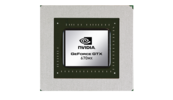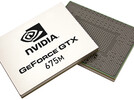NVIDIA GeForce GTX 670MX vs NVIDIA GeForce GTX 675M SLI
NVIDIA GeForce GTX 670MX ► remove from comparison
Die NVIDIA GeForce GTX 670MX ist eine High-End Grafikkarte für Notebooks. Trotz des ähnlichen Namens zur Fermi-basierten GTX 670M basiert die GTX 670MX auf dem neueren Kepler GK106 Kern in 28nm. Im Vergleich zur GTX 675MX bietet die 670MX einen verringerten Speicherbus und langsamer getaktete Speicherchips. Dadurch ist die Speicherbandbreite von 115,2 GB/s auf 67,2 GB/s reduziert.
Architektur
Mit Kepler löst Nvidia die bisherige Fermi-Architektur ab, die unter anderem bei verschiedenen Chips und Modellen der GeForce-500M-Serie zum Einsatz kam. Der GK106 verfügt als Kepler-Chip über 5 Shader-Blöcke mit je 192 CUDA Cores, die vom Hersteller mit dem Kürzel SMX bezeichnet werden. Bei der 670MX sind davon alle 5 aktiviert. Zwei SMX bilden zusammen mit zwei Polymorph Engines und einer gemeinsamen Raster Engine einen sogenannten GPC (Graphics Processing Cluster). Da die Shader keine eigene Takt-Domain mehr besitzen (Hot Clock), entspricht die Rechenleistung in etwa der Hälfte der Einheiten der Fermi-Architektur mit doppelter Taktrate. Diese Änderung ist einer der Gründe dafür, dass sich laut Nvidia die Energieeffizienz gegenüber dem Vorgänger verdoppelt hat. Auch die Tesselations-Leistung soll - speziell bei hohen Faktoren - noch einmal deutlich verbessert worden sein.
Als weitere Neuerungen werden zudem erstmals PCIe 3.0 sowie ein noch nicht näher bezeichneter, optionaler Turbo-Modus unterstützt. Dieser kann - ausreichende Kühlungsreserven vorausgesetzt - die Kerntaktrate um bis zu 15 Prozent anheben. Da der Turbo vom BIOS gesteuert wird, steht er, falls vom Notebook-Hersteller implementiert, unabhängig vom Betriebssystem zur Verfügung.
Leistung
Die Leistung der GeForce GTX 670MX liegt etwas oberhalb der alten GTX 670M und dadurch in der Oberklasse der Notebookgrafikkarten in 2012. Die meisten anspruchsvollen Spiele wie Anno 2070 oder Battlefield 3 sind somit in hohen Auflösungen und Detailstufen flüssig darstellbar, teils auch mit zusätzlichem Antialiasing (Stand 2012).
Features
Das aktualisierte Featureset umfasst nun die Unterstützung von bis zu 4 aktiven Displays (mit Optimus u.U. weniger), die mit einer maximalen Auflösung von 3.840 x 2.160 Pixeln zum Beispiel über DisplayPort 1.2 oder HDMI 1.4a angesteuert werden können. HD-Audio-Formate wie Dolby True HD und DTS-HD lassen sich als Bitstream an einen geeigneten Receiver senden. Wie in der Vergangenheit kann jedoch auch weiterhin 3D Vision nicht mit Optimus-Unterstützung kombiniert werden.
Der HD-Videoprozessor der fünften Generation (VP5) wurde vom GF119-Chip übernommen. Dieser kann die Formate MPEG-1, MPEG-2, MPEG-4, H.264 und VC1/WMV9 bis zu einer Auflösung von 4k decodieren und somit den Prozessor entlasten. Auch zwei parallele Streams, beispielsweise für Picture-in-Picture bei einer Blu-Ray, sind möglich. Eine weitere Neuerung ist die Integration eines dedizierten Videoencoders ähnlich Intels Quick Sync, der über die NVENC-API angesprochen werden kann.
Die Leistungsaufnahme der GTX 670MX sollte auf dem selben Level oder etwas unterhalb der GTX 670M liegen, somit eignet sich die Grafikkarte für große und schwere Notebooks (15-17"+). Bei geringer Last helfen zusätzliche Taktstufen, um Energie zu sparen. Im Leerlauf kann die GPU mithilfe der Optimus-Technologie zugunsten einer integrierten Grafikeinheit auch vollständig deaktiviert werden (nur ohne 3D Vision).
NVIDIA GeForce GTX 675M SLI ► remove from comparison
Die NVIDIA GeForce GTX 675M SLI ist eine High-End Grafiklösung für Laptops welche auf zwei "Fermi" Chips (GF114) basiert. Die beiden Grafikkarten werden durch eine SLI Bridge verbunden und rendern normalerweise abwechselnd ein Bild (AFR). Dadurch kann es auch zu Mikrorucklern kommen (ungleichmäßige Abstände zwischen zwei Bildern führen zu spürbaren Rucklern trotz flüssiger fps Raten von etwa 30 fps). Die GTX 675M SLI unterstützt DirectX 11 und braucht sehr viel Strom (2x 100 Watt für das exakt identisch mit der GTX 580M .
Im Gegensatz zur GeForce GTX 485M basiert jede einzelne GTX 675M auf dem auf Stromverbrauch optimierten GF114 Chip und nicht mehr dem GF104. Die Architektur und Performance pro MHz ist dadurch nicht betroffen, jedoch sind nun höhere Taktfrequenzen bei vergleichbarem Stromverbrauch möglich. Der GF114 basiert auf der Fermi Architektur und bietet im Vollausbau 384 Kerne, 64 Textur-Einheiten (TMUs) und 32 Raster-Operations-Einheiten (ROPs). Mehr Informationen zur Architektur des ähnlichen GF104 finden Sie auf der Seite der GeForce GTX 485M .
Die Grafikleistung der 675M SLI liegt dank der höheren Taktraten etwas oberhalb der 485M SLI und auf einem Niveau mit der GTX 580M SLI . Dadurch kann man anspruchsvolle Spiele wie Crysis 2, Dirt 3 oder Metro 2033 in 1920x1080 und hohen Details flüssig spielen. Die meisten Spiele sind auch mit Antialiasing und maximalen Details flüssig darstellbar.
Wie auch die GeForce 300M Serie, bietet die Geforce GTX 675M PureVideo HD mit dem VideoProcessor 4 (VP4) und VDPAU Feaure Set C. Dadurch kann die Grafikkarte HD Videos in H.254, VC-1, MPEG-2 und MPEG-4 ASP vollständig dekodieren ohne den Prozessor zu belasten. Mittels Flash 10.1 können auch Flash Videos GPU unterstützt wiedergegeben werden.
Eine Neuheit des GF114 Chips im Vergleich zum GF100 (GTX 480M) ist die Unterstützung der Bitstream Übertragung von HD Audio (Blu-Ray) per HDMI Anschluss. Wie die Radeon HD 5850, kann die GTX 675M Dolby True HD und DTS-HD per Bitstream ohne Qualitätsverlust an einen geeigneten Receiver übertragen.
Die Rendering Cores der Nvidia GeForce GTX 675M können dank CUDA und DirectCompute Unterstützung auch für generelle Berechnungen (z.B. das Encodieren von Videos) verwendet werden. Weiters kann man mittels PhysX die Rechenkerne für Physikberechnungen einsetzen. So kann man z.B. eine Grafikkarte dediziert für PhysX abstellen und die zweite Karte des SLI Verbunds berechnet die Grafikausgabe.
Im Vergleich zu Desktop Grafikkarten, ist die GeForce GTX 675M SLI vergleichbar mit zwei GeForce GTX 560Ti im SLI Modus. Die 560Ti ist jedoch deutlich höher getaktet und dadurch schneller.
NVIDIA GeForce GTX 670MX NVIDIA GeForce GTX 675M SLI GeForce GTX 600M Serie Codename N13E-GR N12E-GTX2 Architektur Kepler Fermi Pipelines 960 - unified 768 - unified Kerntakt 600 MHz 620 MHz Speichertakt 2800 MHz 3000 MHz Speicherbandbreite 192 Bit 256 Bit Speichertyp GDDR5 GDDR5 Shared Memory nein nein API DirectX 11, Shader 5.1, OpenGL 4.2 DirectX 11, Shader 5.0 Stromverbrauch 75 Watt 2x 100 Watt Transistors 2.5 Billion Herstellungsprozess 28 nm 40 nm Features Optimus, SLI, PhysX,
Verde Drivers,
CUDA, 3D Vision, 3DTV
Play Optimus, SLI, PhysX, Verde Drivers, CUDA, 3D Vision, 3DTV Play Notebookgröße groß (17" z.B.) groß (17" z.B.) Erscheinungsdatum 01.10.2012 06.01.2011 Herstellerseite www.geforce.com www.nvidia.com Shadertakt 1240 MHz
Benchmarks 3DMark - 3DMark Fire Strike Standard Score
2261 Points (4%)
3DMark - 3DMark Fire Strike Standard Graphics
2371 Points (3%)
3DMark 11 - 3DM11 Performance Score
3768 Points (5%)
6389 Points (9%)
3DMark 11 - 3DM11 Performance GPU
min: 3567 avg: 3587 median: 3587 (3%) max: 3607 Points
6407 Points (6%)
3DMark Vantage + NVIDIA GeForce GTX 670MX 3DMark Vantage - 3DM Vant. Perf. total
min: 14521 avg: 14922 median: 14530 (4%) max: 15715 Points
3DM Vant. Perf. total + NVIDIA GeForce GTX 675M SLI
18405 Points (5%)
3DM Vant. Perf. GPU no PhysX + NVIDIA GeForce GTX 670MX 3DMark Vantage - 3DM Vant. Perf. GPU no PhysX
min: 12997 avg: 13008 median: 13008 (7%) max: 13019 Points
3DM Vant. Perf. GPU no PhysX + NVIDIA GeForce GTX 675M SLI
17631 Points (10%)
3DMark 03 - 3DMark 03 - Standard
min: 46884 avg: 47429 median: 47429 (25%) max: 47974 Points
3DMark 05 - 3DMark 05 - Standard
min: 26819 avg: 27041 median: 27040.5 (30%) max: 27262 Points
3DMark 06 3DMark 06 - Standard 1280x1024 + NVIDIA GeForce GTX 670MX
min: 19027 avg: 20667 median: 20268 (27%) max: 22706 Points
Unigine Heaven 3.0 - Unigine Heaven 3.0 DX 11
min: 34.1 avg: 34.4 median: 34.3 (11%) max: 34.9 fps
Unigine Heaven 2.1 - Heaven 2.1 high
45.2 fps (8%)
SPECviewperf 11 + NVIDIA GeForce GTX 670MX SPECviewperf 11 - specvp11 snx-01
1.7 fps (1%)
specvp11 tcvis-02 + NVIDIA GeForce GTX 670MX SPECviewperf 11 - specvp11 tcvis-02
0.8 fps (0%)
specvp11 sw-02 + NVIDIA GeForce GTX 670MX SPECviewperf 11 - specvp11 sw-02
8.4 fps (6%)
specvp11 proe-05 + NVIDIA GeForce GTX 670MX SPECviewperf 11 - specvp11 proe-05
1.2 fps (1%)
specvp11 maya-03 + NVIDIA GeForce GTX 670MX SPECviewperf 11 - specvp11 maya-03
9.8 fps (7%)
specvp11 lightwave-01 + NVIDIA GeForce GTX 670MX SPECviewperf 11 - specvp11 lightwave-01
14.3 fps (15%)
specvp11 ensight-04 + NVIDIA GeForce GTX 670MX SPECviewperf 11 - specvp11 ensight-04
14.3 fps (7%)
specvp11 catia-03 + NVIDIA GeForce GTX 670MX SPECviewperf 11 - specvp11 catia-03
6.2 fps (3%)
Cinebench R11.5 Cinebench R11.5 OpenGL 64 Bit + NVIDIA GeForce GTX 670MX Cinebench R11.5 - Cinebench R11.5 OpenGL 64 Bit
47 fps (16%)
Average Benchmarks NVIDIA GeForce GTX 670MX → 100% n=4 Average Benchmarks NVIDIA GeForce GTX 675M SLI → 153% n=4
- Bereich der Benchmarkergebnisse für diese Grafikkarte
- Durchschnittliche Benchmarkergebnisse für diese Grafikkarte
* Smaller numbers mean a higher performance
1 This benchmark is not used for the average calculation
Spiele-Benchmarks Die folgenden Benchmarks basieren auf unseren Spieletests mit Testnotebooks. Die Performance dieser Grafikkarte bei den gelisteten Spielen ist abhängig von der verwendeten CPU, Speicherausstattung, Treiber und auch Betriebssystem. Dadurch müssen die untenstehenden Werte nicht repräsentativ sein. Detaillierte Informationen über das verwendete System sehen Sie nach einem Klick auf den fps-Wert.
100%
GeForce GTX 670MX:
60 [X] Schenker XMG P502 Intel Core i7-3610QM 2.3GHz
GeForce GTX 670MX
fps
100%
GeForce GTX 670MX:
57.8 [X] Schenker XMG P502 Intel Core i7-3610QM 2.3GHz
GeForce GTX 670MX
fps
100%
GeForce GTX 670MX:
48.1 [X] Schenker XMG P502 Intel Core i7-3610QM 2.3GHz
GeForce GTX 670MX
fps
100%
GeForce GTX 670MX:
35.3 [X] Schenker XMG P502 Intel Core i7-3610QM 2.3GHz
GeForce GTX 670MX
fps
100%
GeForce GTX 670MX:
54.6 [X] Schenker XMG P502 Intel Core i7-3610QM 2.3GHz
GeForce GTX 670MX
fps
100%
GeForce GTX 670MX:
39.7 [X] Schenker XMG P502 Intel Core i7-3610QM 2.3GHz
GeForce GTX 670MX
fps
100%
GeForce GTX 670MX:
34.4 [X] Schenker XMG P502 Intel Core i7-3610QM 2.3GHz
GeForce GTX 670MX
fps
100%
GeForce GTX 670MX:
18.5 [X] Schenker XMG P502 Intel Core i7-3610QM 2.3GHz
GeForce GTX 670MX
fps
100%
GeForce GTX 670MX:
61 [X] Schenker XMG P502 Intel Core i7-3610QM 2.3GHz
GeForce GTX 670MX
fps
100%
GeForce GTX 670MX:
50.2 [X] Schenker XMG P502 Intel Core i7-3610QM 2.3GHz
GeForce GTX 670MX
fps
100%
GeForce GTX 670MX:
31.8 [X] Schenker XMG P502 Intel Core i7-3610QM 2.3GHz
GeForce GTX 670MX
fps
100%
GeForce GTX 670MX:
16.3 [X] Schenker XMG P502 Intel Core i7-3610QM 2.3GHz
GeForce GTX 670MX
fps
100%
GeForce GTX 670MX:
82.5 [X] Schenker XMG P502 Intel Core i7-3610QM 2.3GHz
GeForce GTX 670MX
fps
100%
GeForce GTX 670MX:
38.9 [X] Schenker XMG P502 Intel Core i7-3610QM 2.3GHz
GeForce GTX 670MX
fps
100%
GeForce GTX 670MX:
22.3 [X] Schenker XMG P502 Intel Core i7-3610QM 2.3GHz
GeForce GTX 670MX
fps
100%
GeForce GTX 670MX:
13.7 [X] Schenker XMG P502 Intel Core i7-3610QM 2.3GHz
GeForce GTX 670MX
fps
100%
GeForce GTX 670MX:
81.1 [X] Schenker XMG P502 Intel Core i7-3610QM 2.3GHz
GeForce GTX 670MX
fps
100%
GeForce GTX 670MX:
65.5 [X] Schenker XMG P502 Intel Core i7-3610QM 2.3GHz
GeForce GTX 670MX
fps
100%
GeForce GTX 670MX:
38 [X] Schenker XMG P502 Intel Core i7-3610QM 2.3GHz
GeForce GTX 670MX
fps
100%
GeForce GTX 670MX:
19.2 [X] Schenker XMG P502 Intel Core i7-3610QM 2.3GHz
GeForce GTX 670MX
fps
100%
GeForce GTX 670MX:
98.4 [X] Schenker XMG P502 Intel Core i7-3610QM 2.3GHz
GeForce GTX 670MX
fps
100%
GeForce GTX 670MX:
68.8 [X] Schenker XMG P502 Intel Core i7-3610QM 2.3GHz
GeForce GTX 670MX
fps
100%
GeForce GTX 670MX:
44.9 [X] Schenker XMG P502 Intel Core i7-3610QM 2.3GHz
GeForce GTX 670MX
fps
100%
GeForce GTX 670MX:
18.6 [X] Schenker XMG P502 Intel Core i7-3610QM 2.3GHz
GeForce GTX 670MX
fps
100%
GeForce GTX 670MX:
201 [X] Schenker XMG P502 Intel Core i7-3610QM 2.3GHz
GeForce GTX 670MX
fps
100%
GeForce GTX 670MX:
132 [X] Schenker XMG P502 Intel Core i7-3610QM 2.3GHz
GeForce GTX 670MX
fps
100%
GeForce GTX 670MX:
64 [X] Schenker XMG P502 Intel Core i7-3610QM 2.3GHz
GeForce GTX 670MX
fps
100%
GeForce GTX 670MX:
31 [X] Schenker XMG P502 Intel Core i7-3610QM 2.3GHz
GeForce GTX 670MX
fps
100%
GeForce GTX 670MX:
154 [X] Schenker XMG P502 Intel Core i7-3610QM 2.3GHz
GeForce GTX 670MX
fps
100%
GeForce GTX 670MX:
120 [X] Schenker XMG P502 Intel Core i7-3610QM 2.3GHz
GeForce GTX 670MX
fps
100%
GeForce GTX 670MX:
111 [X] Schenker XMG P502 Intel Core i7-3610QM 2.3GHz
GeForce GTX 670MX
fps
100%
GeForce GTX 670MX:
61 [X] Schenker XMG P502 Intel Core i7-3610QM 2.3GHz
GeForce GTX 670MX
fps
100%
GeForce GTX 670MX:
450.4 [X] Schenker XMG P502 Intel Core i7-3610QM 2.3GHz
GeForce GTX 670MX
fps
100%
GeForce GTX 670MX:
316.9 [X] Schenker XMG P502 Intel Core i7-3610QM 2.3GHz
GeForce GTX 670MX
fps
100%
GeForce GTX 670MX:
315.9 [X] Schenker XMG P502 Intel Core i7-3610QM 2.3GHz
GeForce GTX 670MX
fps
100%
GeForce GTX 670MX:
238.6 [X] Schenker XMG P502 Intel Core i7-3610QM 2.3GHz
GeForce GTX 670MX
fps
100%
GeForce GTX 670MX:
156.8 [X] Schenker XMG P502 Intel Core i7-3610QM 2.3GHz
GeForce GTX 670MX
fps
100%
GeForce GTX 670MX:
116.4 [X] Schenker XMG P502 Intel Core i7-3610QM 2.3GHz
GeForce GTX 670MX
fps
100%
GeForce GTX 670MX:
91.3 [X] Schenker XMG P502 Intel Core i7-3610QM 2.3GHz
GeForce GTX 670MX
fps
100%
GeForce GTX 670MX:
16.6 [X] Schenker XMG P502 Intel Core i7-3610QM 2.3GHz
GeForce GTX 670MX
fps
100%
GeForce GTX 670MX:
77 [X] Schenker XMG P502 Intel Core i7-3610QM 2.3GHz
GeForce GTX 670MX
fps
100%
GeForce GTX 670MX:
67.9 [X] Schenker XMG P502 Intel Core i7-3610QM 2.3GHz
GeForce GTX 670MX
fps
100%
GeForce GTX 670MX:
38.1 [X] Schenker XMG P502 Intel Core i7-3610QM 2.3GHz
GeForce GTX 670MX
fps
100%
GeForce GTX 670MX:
24.8 [X] Schenker XMG P502 Intel Core i7-3610QM 2.3GHz
GeForce GTX 670MX
fps
100%
GeForce GTX 670MX:
119.6 [X] Schenker XMG P502 Intel Core i7-3610QM 2.3GHz
GeForce GTX 670MX
fps
100%
GeForce GTX 670MX:
84.4 [X] Schenker XMG P502 Intel Core i7-3610QM 2.3GHz
GeForce GTX 670MX
fps
100%
GeForce GTX 670MX:
33.8 [X] Schenker XMG P502 Intel Core i7-3610QM 2.3GHz
GeForce GTX 670MX
fps
100%
GeForce GTX 670MX:
17.4 [X] Schenker XMG P502 Intel Core i7-3610QM 2.3GHz
GeForce GTX 670MX
fps
100%
GeForce GTX 670MX:
93.3 [X] Schenker XMG P502 Intel Core i7-3610QM 2.3GHz
GeForce GTX 670MX
fps
100%
GeForce GTX 670MX:
82.8 [X] Schenker XMG P502 Intel Core i7-3610QM 2.3GHz
GeForce GTX 670MX
fps
100%
GeForce GTX 670MX:
38.8 [X] Schenker XMG P502 Intel Core i7-3610QM 2.3GHz
GeForce GTX 670MX
fps
100%
GeForce GTX 670MX:
17.9 [X] Schenker XMG P502 Intel Core i7-3610QM 2.3GHz
GeForce GTX 670MX
fps
100%
GeForce GTX 670MX:
106.8 [X] Schenker XMG P502 Intel Core i7-3610QM 2.3GHz
GeForce GTX 670MX
fps
100%
GeForce GTX 670MX:
85 [X] Schenker XMG P502 Intel Core i7-3610QM 2.3GHz
GeForce GTX 670MX
fps
100%
GeForce GTX 670MX:
44 [X] Schenker XMG P502 Intel Core i7-3610QM 2.3GHz
GeForce GTX 670MX
fps
100%
GeForce GTX 670MX:
42.7 [X] Schenker XMG P502 Intel Core i7-3610QM 2.3GHz
GeForce GTX 670MX
fps
100%
GeForce GTX 670MX:
35.8 [X] Schenker XMG P502 Intel Core i7-3610QM 2.3GHz
GeForce GTX 670MX
fps
100%
GeForce GTX 670MX:
23.2 [X] Schenker XMG P502 Intel Core i7-3610QM 2.3GHz
GeForce GTX 670MX
fps
100%
GeForce GTX 670MX:
11 [X] Schenker XMG P502 Intel Core i7-3610QM 2.3GHz
GeForce GTX 670MX
fps
100%
GeForce GTX 670MX:
146.5 [X] Schenker XMG P502 Intel Core i7-3610QM 2.3GHz
GeForce GTX 670MX
fps
100%
GeForce GTX 670MX:
111.3 [X] Schenker XMG P502 Intel Core i7-3610QM 2.3GHz
GeForce GTX 670MX
fps
100%
GeForce GTX 670MX:
101.7 [X] Schenker XMG P502 Intel Core i7-3610QM 2.3GHz
GeForce GTX 670MX
fps
100%
GeForce GTX 670MX:
28.7 [X] Schenker XMG P502 Intel Core i7-3610QM 2.3GHz
GeForce GTX 670MX
fps
100%
GeForce GTX 670MX:
71.9 [X] Schenker XMG P502 Intel Core i7-3610QM 2.3GHz
GeForce GTX 670MX
fps
100%
GeForce GTX 670MX:
57.6 [X] Schenker XMG P502 Intel Core i7-3610QM 2.3GHz
GeForce GTX 670MX
fps
100%
GeForce GTX 670MX:
34.3 [X] Schenker XMG P502 Intel Core i7-3610QM 2.3GHz
GeForce GTX 670MX
fps
100%
GeForce GTX 670MX:
18.3 [X] Schenker XMG P502 Intel Core i7-3610QM 2.3GHz
GeForce GTX 670MX
fps
100%
GeForce GTX 670MX:
158.1 [X] Schenker XMG P502 Intel Core i7-3610QM 2.3GHz
GeForce GTX 670MX
fps
100%
GeForce GTX 670MX:
91.8 [X] Schenker XMG P502 Intel Core i7-3610QM 2.3GHz
GeForce GTX 670MX
fps
100%
GeForce GTX 670MX:
78.3 [X] Schenker XMG P502 Intel Core i7-3610QM 2.3GHz
GeForce GTX 670MX
fps
100%
GeForce GTX 670MX:
27.9 [X] Schenker XMG P502 Intel Core i7-3610QM 2.3GHz
GeForce GTX 670MX
fps
100%
GeForce GTX 670MX:
238.2 [X] Schenker XMG P502 Intel Core i7-3610QM 2.3GHz
GeForce GTX 670MX
fps
100%
GeForce GTX 670MX:
102.1 [X] Schenker XMG P502 Intel Core i7-3610QM 2.3GHz
GeForce GTX 670MX
fps
100%
GeForce GTX 670MX:
84.6 [X] Schenker XMG P502 Intel Core i7-3610QM 2.3GHz
GeForce GTX 670MX
fps
100%
GeForce GTX 670MX:
34.5 [X] Schenker XMG P502 Intel Core i7-3610QM 2.3GHz
GeForce GTX 670MX
fps
100%
GeForce GTX 670MX:
77.6 [X] Schenker XMG P502 Intel Core i7-3610QM 2.3GHz
GeForce GTX 670MX
fps
100%
GeForce GTX 670MX:
40.9 [X] Schenker XMG P502 Intel Core i7-3610QM 2.3GHz
GeForce GTX 670MX
fps
100%
GeForce GTX 670MX:
34.5 [X] Schenker XMG P502 Intel Core i7-3610QM 2.3GHz
GeForce GTX 670MX
fps
100%
GeForce GTX 670MX:
21.7 [X] Schenker XMG P502 Intel Core i7-3610QM 2.3GHz
GeForce GTX 670MX
fps
100%
GeForce GTX 670MX:
201.1 [X] Schenker XMG P502 Intel Core i7-3610QM 2.3GHz
GeForce GTX 670MX
fps
100%
GeForce GTX 670MX:
104.9 [X] Schenker XMG P502 Intel Core i7-3610QM 2.3GHz
GeForce GTX 670MX
fps
100%
GeForce GTX 670MX:
66.5 [X] Schenker XMG P502 Intel Core i7-3610QM 2.3GHz
GeForce GTX 670MX
fps
100%
GeForce GTX 670MX:
28 [X] Schenker XMG P502 Intel Core i7-3610QM 2.3GHz
GeForce GTX 670MX
fps
100%
GeForce GTX 670MX:
84.9 [X] Schenker XMG P502 Intel Core i7-3610QM 2.3GHz
GeForce GTX 670MX
fps
100%
GeForce GTX 670MX:
50.7 [X] Schenker XMG P502 Intel Core i7-3610QM 2.3GHz
GeForce GTX 670MX
fps
100%
GeForce GTX 670MX:
35 [X] Schenker XMG P502 Intel Core i7-3610QM 2.3GHz
GeForce GTX 670MX
fps
100%
GeForce GTX 670MX:
13.8 [X] Schenker XMG P502 Intel Core i7-3610QM 2.3GHz
GeForce GTX 670MX
fps
100%
GeForce GTX 670MX:
291.4 [X] Schenker XMG P502 Intel Core i7-3610QM 2.3GHz
GeForce GTX 670MX
fps
100%
GeForce GTX 670MX:
143.9 [X] Schenker XMG P502 Intel Core i7-3610QM 2.3GHz
GeForce GTX 670MX
fps
100%
GeForce GTX 670MX:
109.7 [X] Schenker XMG P502 Intel Core i7-3610QM 2.3GHz
GeForce GTX 670MX
fps
100%
GeForce GTX 670MX:
66 [X] Schenker XMG P502 Intel Core i7-3610QM 2.3GHz
GeForce GTX 670MX
fps
100%
GeForce GTX 670MX:
110.7 [X] Deviltech HellMachine Intel Core i7-3630QM 2.4GHz
GeForce GTX 670MX
fps
100%
GeForce GTX 670MX:
82.2 [X] Deviltech HellMachine Intel Core i7-3630QM 2.4GHz
GeForce GTX 670MX
fps
100%
GeForce GTX 670MX:
43.3 44.2 [X] Deviltech HellMachine Intel Core i7-3630QM 2.4GHz
GeForce GTX 670MX
~ 44 fps
100%
GeForce GTX 670MX:
13.2 13.7 [X] Deviltech HellMachine Intel Core i7-3630QM 2.4GHz
GeForce GTX 670MX
~ 13 fps
100%
GeForce GTX 670MX:
57.3 [X] Deviltech HellMachine Intel Core i7-3630QM 2.4GHz
GeForce GTX 670MX
fps
100%
GeForce GTX 670MX:
54.7 [X] Deviltech HellMachine Intel Core i7-3630QM 2.4GHz
GeForce GTX 670MX
58 ~ 56 fps
100%
GeForce GTX 670MX:
21.2 [X] Deviltech HellMachine Intel Core i7-3630QM 2.4GHz
GeForce GTX 670MX
21.6 ~ 21 fps
100%
GeForce GTX 670MX:
69.2 [X] Deviltech HellMachine Intel Core i7-3630QM 2.4GHz
GeForce GTX 670MX
fps
100%
GeForce GTX 670MX:
59.4 [X] Deviltech HellMachine Intel Core i7-3630QM 2.4GHz
GeForce GTX 670MX
fps
100%
GeForce GTX 670MX:
30.3 30.9 [X] Deviltech HellMachine Intel Core i7-3630QM 2.4GHz
GeForce GTX 670MX
~ 31 fps
100%
GeForce GTX 670MX:
12.6 12.7 [X] Deviltech HellMachine Intel Core i7-3630QM 2.4GHz
GeForce GTX 670MX
~ 13 fps
100%
GeForce GTX 670MX:
128.4 [X] Deviltech HellMachine Intel Core i7-3630QM 2.4GHz
GeForce GTX 670MX
fps
100%
GeForce GTX 670MX:
113.1 [X] Deviltech HellMachine Intel Core i7-3630QM 2.4GHz
GeForce GTX 670MX
fps
100%
GeForce GTX 670MX:
64.2 78.6 [X] Deviltech HellMachine Intel Core i7-3630QM 2.4GHz
GeForce GTX 670MX
~ 71 fps
100%
GeForce GTX 670MX:
39.7 46.2 [X] Deviltech HellMachine Intel Core i7-3630QM 2.4GHz
GeForce GTX 670MX
~ 43 fps
100%
GeForce GTX 670MX:
60 [X] Deviltech HellMachine Intel Core i7-3630QM 2.4GHz
GeForce GTX 670MX
fps
100%
GeForce GTX 670MX:
60 [X] Deviltech HellMachine Intel Core i7-3630QM 2.4GHz
GeForce GTX 670MX
fps
100%
GeForce GTX 670MX:
49.6 49.8 [X] Deviltech HellMachine Intel Core i7-3630QM 2.4GHz
GeForce GTX 670MX
~ 50 fps
100%
GeForce GTX 670MX:
28.5 29 [X] Deviltech HellMachine Intel Core i7-3630QM 2.4GHz
GeForce GTX 670MX
~ 29 fps
100%
GeForce GTX 670MX:
117.1 [X] Deviltech HellMachine Intel Core i7-3630QM 2.4GHz
GeForce GTX 670MX
fps
100%
GeForce GTX 670MX:
78 [X] Deviltech HellMachine Intel Core i7-3630QM 2.4GHz
GeForce GTX 670MX
fps
100%
GeForce GTX 670MX:
62.6 [X] Deviltech HellMachine Intel Core i7-3630QM 2.4GHz
GeForce GTX 670MX
fps
100%
GeForce GTX 670MX:
25 [X] Deviltech HellMachine Intel Core i7-3630QM 2.4GHz
GeForce GTX 670MX
fps
100%
GeForce GTX 670MX:
129.3 [X] Deviltech HellMachine Intel Core i7-3630QM 2.4GHz
GeForce GTX 670MX
fps
100%
GeForce GTX 670MX:
127.2 [X] Deviltech HellMachine Intel Core i7-3630QM 2.4GHz
GeForce GTX 670MX
fps
100%
GeForce GTX 670MX:
114.9 116.6 [X] Deviltech HellMachine Intel Core i7-3630QM 2.4GHz
GeForce GTX 670MX
~ 116 fps
100%
GeForce GTX 670MX:
74.9 75.4 [X] Deviltech HellMachine Intel Core i7-3630QM 2.4GHz
GeForce GTX 670MX
~ 75 fps
100%
GeForce GTX 670MX:
115.4 [X] Deviltech HellMachine Intel Core i7-3630QM 2.4GHz
GeForce GTX 670MX
fps
100%
GeForce GTX 670MX:
74.2 [X] Deviltech HellMachine Intel Core i7-3630QM 2.4GHz
GeForce GTX 670MX
fps
100%
GeForce GTX 670MX:
65.8 [X] Deviltech HellMachine Intel Core i7-3630QM 2.4GHz
GeForce GTX 670MX
fps
100%
GeForce GTX 670MX:
38.2 [X] Deviltech HellMachine Intel Core i7-3630QM 2.4GHz
GeForce GTX 670MX
fps
100%
GeForce GTX 670MX:
472.1 [X] Deviltech HellMachine Intel Core i7-3630QM 2.4GHz
GeForce GTX 670MX
fps
100%
GeForce GTX 670MX:
339.9 [X] Deviltech HellMachine Intel Core i7-3630QM 2.4GHz
GeForce GTX 670MX
fps
100%
GeForce GTX 670MX:
296.3 [X] Deviltech HellMachine Intel Core i7-3630QM 2.4GHz
GeForce GTX 670MX
fps
100%
GeForce GTX 670MX:
180.6 [X] Deviltech HellMachine Intel Core i7-3630QM 2.4GHz
GeForce GTX 670MX
fps
100%
GeForce GTX 670MX:
154 [X] Deviltech HellMachine Intel Core i7-3630QM 2.4GHz
GeForce GTX 670MX
fps
100%
GeForce GTX 670MX:
122 [X] Deviltech HellMachine Intel Core i7-3630QM 2.4GHz
GeForce GTX 670MX
fps
100%
GeForce GTX 670MX:
110 111 [X] Deviltech HellMachine Intel Core i7-3630QM 2.4GHz
GeForce GTX 670MX
~ 111 fps
100%
GeForce GTX 670MX:
43 46 [X] Deviltech HellMachine Intel Core i7-3630QM 2.4GHz
GeForce GTX 670MX
~ 45 fps
100%
GeForce GTX 670MX:
109.8 [X] Deviltech HellMachine Intel Core i7-3630QM 2.4GHz
GeForce GTX 670MX
fps
100%
GeForce GTX 670MX:
96.3 [X] Deviltech HellMachine Intel Core i7-3630QM 2.4GHz
GeForce GTX 670MX
fps
100%
GeForce GTX 670MX:
70.2 70.7 [X] Deviltech HellMachine Intel Core i7-3630QM 2.4GHz
GeForce GTX 670MX
~ 70 fps
100%
GeForce GTX 670MX:
45.3 [X] Deviltech HellMachine Intel Core i7-3630QM 2.4GHz
GeForce GTX 670MX
45.4 ~ 45 fps
100%
GeForce GTX 670MX:
86.1 [X] Deviltech HellMachine Intel Core i7-3630QM 2.4GHz
GeForce GTX 670MX
fps
100%
GeForce GTX 670MX:
40.8 47.2 [X] Deviltech HellMachine Intel Core i7-3630QM 2.4GHz
GeForce GTX 670MX
~ 44 fps
100%
GeForce GTX 670MX:
17.9 18.8 [X] Deviltech HellMachine Intel Core i7-3630QM 2.4GHz
GeForce GTX 670MX
~ 18 fps
100%
GeForce GTX 670MX:
244.4 [X] Deviltech HellMachine Intel Core i7-3630QM 2.4GHz
GeForce GTX 670MX
fps
100%
GeForce GTX 670MX:
222.9 [X] Deviltech HellMachine Intel Core i7-3630QM 2.4GHz
GeForce GTX 670MX
fps
100%
GeForce GTX 670MX:
164.4 [X] Deviltech HellMachine Intel Core i7-3630QM 2.4GHz
GeForce GTX 670MX
fps
100%
GeForce GTX 670MX:
95.7 [X] Deviltech HellMachine Intel Core i7-3630QM 2.4GHz
GeForce GTX 670MX
fps
100%
GeForce GTX 670MX:
108.9 [X] Deviltech HellMachine Intel Core i7-3630QM 2.4GHz
GeForce GTX 670MX
fps
100%
GeForce GTX 670MX:
63.2 [X] Deviltech HellMachine Intel Core i7-3630QM 2.4GHz
GeForce GTX 670MX
fps
100%
GeForce GTX 670MX:
132.1 [X] Deviltech HellMachine Intel Core i7-3630QM 2.4GHz
GeForce GTX 670MX
fps
100%
GeForce GTX 670MX:
98.6 [X] Deviltech HellMachine Intel Core i7-3630QM 2.4GHz
GeForce GTX 670MX
fps
100%
GeForce GTX 670MX:
49.1 49.3 [X] Deviltech HellMachine Intel Core i7-3630QM 2.4GHz
GeForce GTX 670MX
~ 49 fps
100%
GeForce GTX 670MX:
13.1 [X] Deviltech HellMachine Intel Core i7-3630QM 2.4GHz
GeForce GTX 670MX
13.1 ~ 13 fps
100%
GeForce GTX 670MX:
72.4 [X] Deviltech HellMachine Intel Core i7-3630QM 2.4GHz
GeForce GTX 670MX
fps
100%
GeForce GTX 670MX:
70 [X] Deviltech HellMachine Intel Core i7-3630QM 2.4GHz
GeForce GTX 670MX
fps
100%
GeForce GTX 670MX:
32.8 [X] Deviltech HellMachine Intel Core i7-3630QM 2.4GHz
GeForce GTX 670MX
32.9 ~ 33 fps
100%
GeForce GTX 670MX:
24.8 [X] Deviltech HellMachine Intel Core i7-3630QM 2.4GHz
GeForce GTX 670MX
25 ~ 25 fps
100%
GeForce GTX 670MX:
93.7 [X] Deviltech HellMachine Intel Core i7-3630QM 2.4GHz
GeForce GTX 670MX
fps
100%
GeForce GTX 670MX:
73.3 [X] Deviltech HellMachine Intel Core i7-3630QM 2.4GHz
GeForce GTX 670MX
fps
100%
GeForce GTX 670MX:
72.3 [X] Deviltech HellMachine Intel Core i7-3630QM 2.4GHz
GeForce GTX 670MX
79.9 ~ 76 fps
100%
GeForce GTX 670MX:
30.8 32.4 [X] Deviltech HellMachine Intel Core i7-3630QM 2.4GHz
GeForce GTX 670MX
~ 32 fps
100%
GeForce GTX 670MX:
236.3 [X] Deviltech HellMachine Intel Core i7-3630QM 2.4GHz
GeForce GTX 670MX
fps
100%
GeForce GTX 670MX:
165.4 [X] Deviltech HellMachine Intel Core i7-3630QM 2.4GHz
GeForce GTX 670MX
fps
100%
GeForce GTX 670MX:
144 [X] Deviltech HellMachine Intel Core i7-3630QM 2.4GHz
GeForce GTX 670MX
fps
100%
GeForce GTX 670MX:
89.5 [X] Deviltech HellMachine Intel Core i7-3630QM 2.4GHz
GeForce GTX 670MX
fps
100%
GeForce GTX 670MX:
88.1 [X] Deviltech HellMachine Intel Core i7-3630QM 2.4GHz
GeForce GTX 670MX
fps
100%
GeForce GTX 670MX:
61.4 [X] Deviltech HellMachine Intel Core i7-3630QM 2.4GHz
GeForce GTX 670MX
fps
100%
GeForce GTX 670MX:
48 [X] Deviltech HellMachine Intel Core i7-3630QM 2.4GHz
GeForce GTX 670MX
fps
100%
GeForce GTX 670MX:
23.4 [X] Deviltech HellMachine Intel Core i7-3630QM 2.4GHz
GeForce GTX 670MX
fps
100%
GeForce GTX 670MX:
59.9 [X] Deviltech HellMachine Intel Core i7-3630QM 2.4GHz
GeForce GTX 670MX
fps
100%
GeForce GTX 670MX:
59.9 [X] Deviltech HellMachine Intel Core i7-3630QM 2.4GHz
GeForce GTX 670MX
fps
100%
GeForce GTX 670MX:
57.6 [X] Deviltech HellMachine Intel Core i7-3630QM 2.4GHz
GeForce GTX 670MX
fps
100%
GeForce GTX 670MX:
79.3 [X] Deviltech HellMachine Intel Core i7-3630QM 2.4GHz
GeForce GTX 670MX
fps
100%
GeForce GTX 670MX:
47.3 [X] Deviltech HellMachine Intel Core i7-3630QM 2.4GHz
GeForce GTX 670MX
fps
100%
GeForce GTX 670MX:
23 [X] Deviltech HellMachine Intel Core i7-3630QM 2.4GHz
GeForce GTX 670MX
fps
100%
GeForce GTX 670MX:
228.4 [X] Deviltech HellMachine Intel Core i7-3630QM 2.4GHz
GeForce GTX 670MX
fps
100%
GeForce GTX 670MX:
102.9 [X] Deviltech HellMachine Intel Core i7-3630QM 2.4GHz
GeForce GTX 670MX
fps
100%
GeForce GTX 670MX:
62.6 63.6 [X] Deviltech HellMachine Intel Core i7-3630QM 2.4GHz
GeForce GTX 670MX
~ 63 fps
100%
GeForce GTX 670MX:
32.3 32.4 [X] Deviltech HellMachine Intel Core i7-3630QM 2.4GHz
GeForce GTX 670MX
~ 32 fps
100%
GeForce GTX 670MX:
81.8 [X] Deviltech HellMachine Intel Core i7-3630QM 2.4GHz
GeForce GTX 670MX
fps
100%
GeForce GTX 670MX:
56.2 61.1 [X] Deviltech HellMachine Intel Core i7-3630QM 2.4GHz
GeForce GTX 670MX
~ 59 fps
100%
GeForce GTX 670MX:
31.8 34.3 [X] Deviltech HellMachine Intel Core i7-3630QM 2.4GHz
GeForce GTX 670MX
~ 33 fps
100%
GeForce GTX 670MX:
263.8 [X] Deviltech HellMachine Intel Core i7-3630QM 2.4GHz
GeForce GTX 670MX
fps
100%
GeForce GTX 670MX:
168.1 [X] Deviltech HellMachine Intel Core i7-3630QM 2.4GHz
GeForce GTX 670MX
fps
100%
GeForce GTX 670MX:
109.8 [X] Deviltech HellMachine Intel Core i7-3630QM 2.4GHz
GeForce GTX 670MX
fps
100%
GeForce GTX 670MX:
61 [X] Deviltech HellMachine Intel Core i7-3630QM 2.4GHz
GeForce GTX 670MX
fps
100%
GeForce GTX 670MX:
95.6 [X] Deviltech HellMachine Intel Core i7-3630QM 2.4GHz
GeForce GTX 670MX
fps
100%
GeForce GTX 670MX:
71.9 [X] Deviltech HellMachine Intel Core i7-3630QM 2.4GHz
GeForce GTX 670MX
fps
100%
GeForce GTX 670MX:
46.5 56.7 [X] Deviltech HellMachine Intel Core i7-3630QM 2.4GHz
GeForce GTX 670MX
~ 52 fps
100%
GeForce GTX 670MX:
19.7 21.8 [X] Deviltech HellMachine Intel Core i7-3630QM 2.4GHz
GeForce GTX 670MX
~ 21 fps
Average Gaming NVIDIA GeForce GTX 670MX → 100% Average Gaming 30-70 fps → 100%




 Deutsch
Deutsch English
English Español
Español Français
Français Italiano
Italiano Nederlands
Nederlands Polski
Polski Português
Português Русский
Русский Türkçe
Türkçe Svenska
Svenska Chinese
Chinese Magyar
Magyar















































